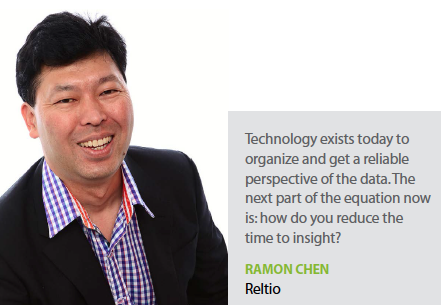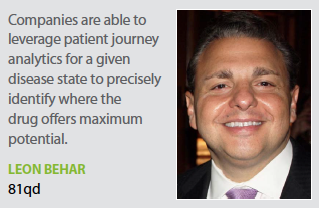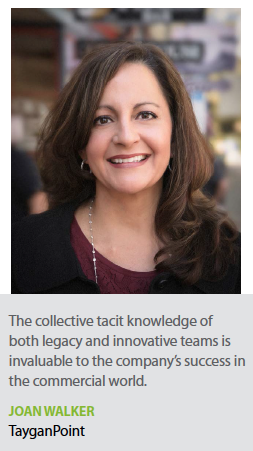As the useful applications of big data in the pharmaceutical and healthcare sector become increasingly apparent, 73% of organizations in the industry are set to begin or increase investment in big data within the next five years, according to business intelligence provider GBI Research.
The report shows that those companies that already use big data and those that do not are in agreement over the impact big data can have on the industry, suggesting that the trend is not heavily biased by the organization’s current status with regard to the technology. The main difference between the two is that those that currently use big data believe more strongly that it can have a big impact on sales, marketing, and commercial activities.
 “The pharmaceutical industry has been under tremendous pressure to do more with less and to maximize returns on both existing and emerging assets," says Leon Behar, Pharm.D., CEO of 81qd. “This can only be accomplished through the integration of analytics into the sales and marketing process."
“The pharmaceutical industry has been under tremendous pressure to do more with less and to maximize returns on both existing and emerging assets," says Leon Behar, Pharm.D., CEO of 81qd. “This can only be accomplished through the integration of analytics into the sales and marketing process."
GBI’s report states that there are a number of factors promoting the use of big data in healthcare, among them advances in technology that have led to an explosion in healthcare-related data generation. The data represent an invaluable resource, which can bring many commercial benefits to organizations if properly utilized and acted upon, although the fundamental properties of big data — its volume, velocity, and variability — make this challenging.
However, that does not mean it can’t be done. Our experts tell us that pharma is finding more and more ways to use big data in its commercialization strategies.
For example, companies are using the power of big data to better profile the complex Integrated Delivery Networks (IDNs) that they are doing business with today. Recently Rivermark, a business analytics and strategic consulting firm, collaborated with LexisNexis Health Care to produce a thorough and more accurate profile of the type 2 diabetes market and the influencers and decision makers that guide the course of the market. By combining provider profile, affiliation, and relationship data with volume-based medical claims intelligence, the Systems of Care deliverable from LexisNexis provided Rivermark with transparent, holistic views of IDN structures and relevant type 2 diabetes claims activities associated with them. Rivermark then integrated LexisNexis output data into its own proprietary thought leadership network mapping and visualization tool, which produced an easily digestible visual representation of the layers of market intelligence.
“The future implications of this are strategically significant for the life-sciences market at large," says Darryl Williams, head, global master data management and platform solutions, LexisNexis. “The dynamic market, now defined by layers of IDN complexity, has created new obstacles for life-sciences organizations in terms of commercial strategy."
 The right combination of data and analytics modeling can be leveraged to overcome these obstacles and deliver valuable market clarity and understanding. With the ability to see transparent macro and micro views of IDNs and understand the connections and activities within them, the industry has the ability to master changing markets to achieve commercial success.
The right combination of data and analytics modeling can be leveraged to overcome these obstacles and deliver valuable market clarity and understanding. With the ability to see transparent macro and micro views of IDNs and understand the connections and activities within them, the industry has the ability to master changing markets to achieve commercial success.
“We provide very focused targeting and segmentation information to brand teams to forecast and size their markets, but what we’re beginning to see now in the commercial space is that the commercial organization wants to expand beyond just the simple targeting and segmentation," Mr. Williams says. “What they’re trying to do now is to quantify the size of the market and their opportunities within those markets."
According to GBI Research, the commercial benefits of big data are incentivizing pharmaceutical and healthcare companies to embrace more technology.
Joan Walker, principal at TayganPoint, says her clients are taking an aggressive approach to these types of strategies due to the pressures to drive business value and to achieve a competitive advantage in the near-term, and technology is helping. “The tools and platforms available today are light years ahead of where they were 10 years ago, in that logic, business rules, dashboards, and analytics come already built into some specialty applications," she says.
It’s these pressures that are pushing the industry toward more big data analysis.
“The industry has no choice but to adopt predictive modeling and those companies that don’t will find themselves falling by the wayside as they will quickly be disadvantaged by those companies that leverage the competitive advantages offered by advanced analytic strategies," Mr. Behar says.
Mr. Behar also points out several ways that companies are meeting their business objectives through big data analytics. For example, companies are able to leverage patient journey analytics for a given disease state to precisely identify where the client’s drug offers maximum potential. Companies are also using network mapping analytics to identify clinical practices with the greatest concentration of potentially viable patients for a clinical trial, as well as identifying physician practices where yet-to-be diagnosed patients with rare diseases are currently being treated for other conditions, and identifying the most influential clinical experts and the clinicians whose behavior they most influence.
Pharma companies have also become more comfortable with utilizing the cloud, which easily enables the use of emerging technologies. The industry is realizing that it is not necessary to establish centers of excellence internally and instead has begun to leverage partners that provide cloud capabilities that can be readily used.
“Some good technology examples around big data are Cassandra, Spark, MapReduce, Hadoop; these technologies have been around for a while, but for life-sciences companies to use them internally allows them to focus on care," Mr. Williams says.
“Leaning on partners that are able to take technology and put it into consumable and usable ways through the cloud, is probably the biggest trend moving forward."
Ms. Walker at TayganPoint has also noticed companies transitioning to cloud-based solutions. One client switched from a data provider that supported various therapeutic areas with single stream functionality to a more full-service, cloud capability that actually costs less. She views this as a smart move for the industry, as it allows data experts to focus on data and bring greater innovation to the big data table.
“The market has become quite competitive and some of the top-tiered data providers such as Informatica and Orchestra Networks have innovative vision and proven platforms that are leaders in the big data space," Ms. Walker says. “There is also a larger pool of boutique integration firms that have top skills and flexibility to create user interfaces to common platforms that leverage industry best practices, simply because it’s what they do day in and day out."
Big data analysis is allowing companies to use information collected from social media to guide its commercial efforts. In the past, this voluminous data was not really accessible or easily analyzed, but technology is creating that opportunity now. This patient-centric and physician-centric data is key in identifying target markets.
“Using profiles and chatter on social media and incorporating that into a market perspective is extremely valuable to pharma these days," Mr. Williams says. “Organizations are starting to figure out ways of parsing and analyzing this data, putting it into an analytical format that can make some sense of it."
One example is analyzing Twitter feeds to determine whether or not a certain experience is emerging among patients using a particular drug or new therapy, or analyzing the social media behavior of practitioners to determine better ways to segment and target those practitioners based on their activity in social media.
There are a lot of data currently being gathered about the digital ecosystem and pharma companies are using this to get a better understanding of how physicians and patients use online social media.
“Where big data starts to get into play is in identifying people from a more social and unstructured data perspective, for example, where do they get their information and where do they engage, whether that’s LinkedIn, Facebook, or even more industry-specific sources such as publications, pubmed.gov, and such," says Ramon Chen, chief marketing officer, VP marketing and product management, Reltio.
 “Second, to improve the efficacy of their drugs and to have more of a patient-centric view, companies are also starting to use big data to understand social consequences or feedback from the deployment of their drugs, with partnerships with network platforms such as PatientsLikeMe, which gives them a window into social chatter and patients talking about how the drugs are really benefitting or not benefitting them," he says. “That level of information really helps in understanding the narrative."
“Second, to improve the efficacy of their drugs and to have more of a patient-centric view, companies are also starting to use big data to understand social consequences or feedback from the deployment of their drugs, with partnerships with network platforms such as PatientsLikeMe, which gives them a window into social chatter and patients talking about how the drugs are really benefitting or not benefitting them," he says. “That level of information really helps in understanding the narrative."
Another source of information that is now more easily analyzed is the immense data flowing from electronic medical and healthcare records.
“EMR and EHR information is obviously very expansive and voluminous but today we are able to put it into consumable visual presentations to allow data scientists to organize it in ways for analysts to reveal meaning from it all," Mr. Williams says.
Pharma does not have to abandon the old to make room for the new, our experts say, noting that legacy systems can stay in place while companies adopt more cloud-based platforms. Companies generally have skilled analyst teams — focused on therapeutic areas — that provide insight into historical trends and guide the approach on deciphering what types of data could be leveraged for future analytics that provide a competitive advantage.
“Looking at alternative, cloud-based, leading-edge platforms that have full-service functionality and provide the capability to migrate legacy data is still relevant and useful," Ms. Walker says. “The collective tacit knowledge of these teams is invaluable and lend themselves to being the engine that drives the company’s success in the commercial world."
Adoption of cloud-based solutions and data analytics does not supplant the legacy models of the industry, but instead supplement them, Mr. Williams says.
“The new adoptions can help facilitate speed to insights and get to the answers faster, but companies are still maintaining their legacy environments," he says. “Organizations have made large investments in a lot of different areas but as new assets become available, there’s definitely a receptivity in the market to explore, and where appropriate, leverage to facilitate this impact."
Mr. Chen cautions that just having the technology is not the endgame, however. All the managed data in the world is no good if it is not available to the people who can interpret it.
“Technology exists today to organize and provide a reliable perspective of the data," he says. “The next part of the equation now is, how to reduce the time to insight so that you’re not waiting on the movement of that data or the synchronization of that data between the operational systems and the analytical warehouses."
In order to succeed, companies will want to explore the entire spectrum of where a big data initiative may help across the commercial spectrum, not just for the problem at hand. For example, if a company has a CRM problem, it may opt to choose a technology that helps improve salesforce or territory alignment. However, that same company may also have a problem with supplies, product alignment, or even distributors.
 Instead of solving each problem with its own initiative, the more effective way is to view the entire picture and create a plan that can solve all issues and at the same time to avoid perpetuating data silos.
Instead of solving each problem with its own initiative, the more effective way is to view the entire picture and create a plan that can solve all issues and at the same time to avoid perpetuating data silos.
“Siloed data, no matter the size, causes issues," Mr. Chen says. “Different perspectives of the same customer, product, or organization mean collaboration is not possible."
One of the strategies being adopted by the industry is the use of data lakes. A data lake is a storage repository that holds a vast amount of raw data in its native format until it is needed. While a hierarchical data warehouse stores data in files or folders, a data lake uses a flat architecture to store data.
“We’re starting to see that being more common as life-sciences companies pull data together and make it accessible and usable to the individuals who can actually interpret what they’re seeing," Mr. Williams says.
Traditionally, data warehouses and data marts are focused on structured data and the transformation of the data into a consumable format. In a data lake, the focus is on the variety depth, and the potential relevance of that data.
The strategy behind a data lake approach is to pull all the data together in one place and then use the technologies that are available to standardize, massage, and structure data in such a way that it can be presented back in a consumable format.
“Data lakes are ways that organizations are getting past the challenge of how to really gain some meaning out all of the voluminous data and multi-structured data sets in a realistic way," Mr. Williams says.
Another way to gain rapid insights is through the use of a business rules management system (BRMS), a software system used to define, deploy, execute, monitor, and maintain the variety and complexity of decision logic that is used by operational systems within an organization or enterprise.
Ms. Walker has had experience with these systems, and they allow companies to manage vast data resources efficiently to create actionable insights. For instance, creating a rule around “class of trade" such as “specialty pharmacy," a segment of the industry addressing the needs of patients with chronic illnesses like cancer and HIV has had significant growth in the market.
“A BRMS provides the ability to manipulate various types of rules that govern the way data are leveraged," she says. “This ultimately enables rapid insights and ability to act on these insights with short-term aggressive strategies in the market."
Because of the high stakes of healthcare, there is a great responsibility to get things right and to pursue continual improvement, ideally with the proper use and analysis of data, Mr. Chen says.
With more data to collect than any other industry: disease states, scientific studies, individual patient info, clinical results, and more, all of that data needs to be turned into actionable information in an increasingly complex digital world.
According to the GBI report, getting it right relies on creative and outside-of-the-box thinking, in both data collection and analytics, to provide competitive differentiation in an industry where many organizations already utilize big data.
Collecting data sets that are differentiated from the data that every other organization is using is what will allow for unique analysis and insights, enabling an organization to recognize patterns that no one else has seen or can see.
When fed into big data systems, ostensibly useless data could reveal interesting patterns in combination with other data sets.
Standards may have to be relaxed for non-typical data — it may be preferable to include data in a ‘‘dirty’’ form rather than exclude it completely. These are all new concepts for pharma.
“We’re seeing a trend where it’s a scenario of evolve or die," Mr. Chen says. “Large companies may have the resources, the money, and technology, and probably already invested millions of dollars 10 years ago to solve a problem, but the problem has changed and the efficiencies of the problem have changed. Their competitors, smaller pharmaceutical start-ups, can now get into the game with better systems and better cloud data management platforms. Their ability to be more agile, to know their customers better — get a 360 degree view — and to be able to service them better at a personalized level is the competitive advantage in this evolving market." (PV)



















